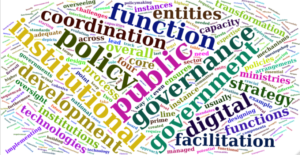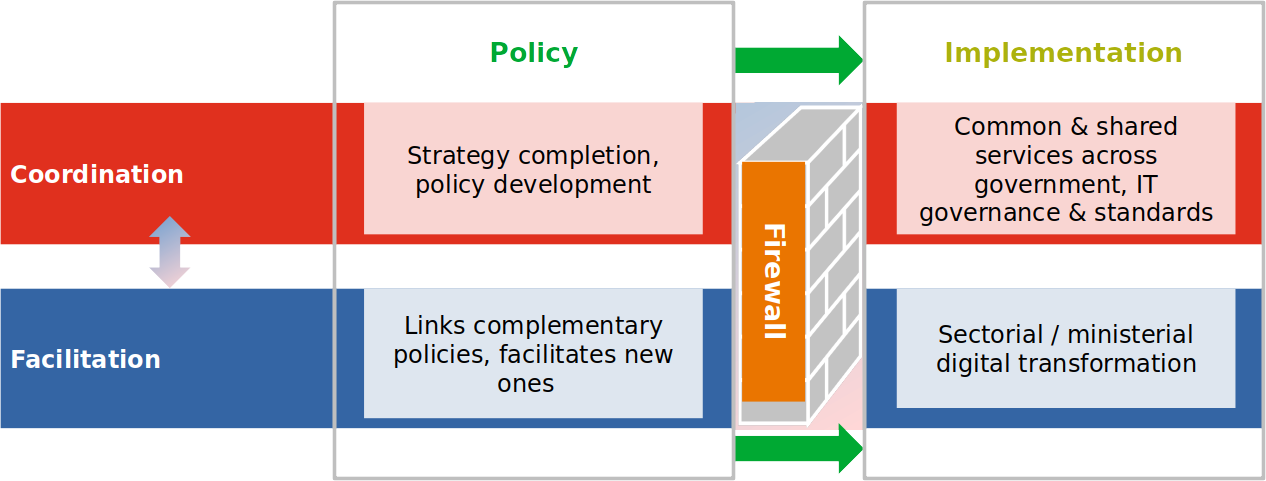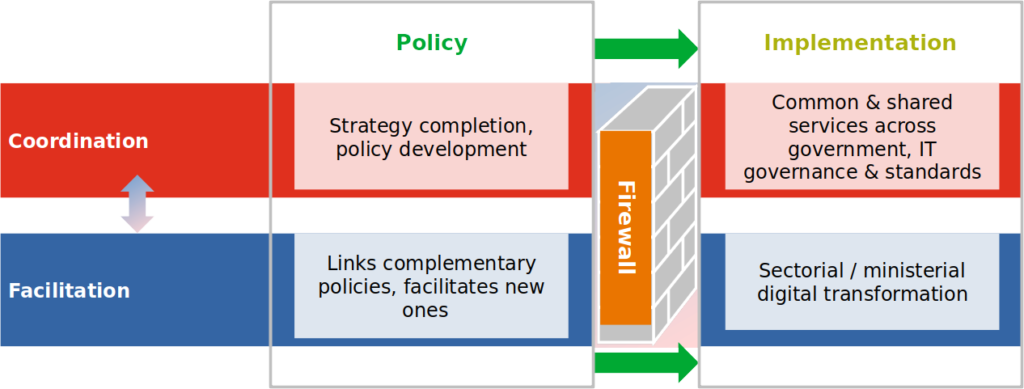Institutions matter, more so for the development and implementation of Digital Government (DG), whose core target is public institutions’ transformation. On the one hand, public institutions should have an array of capacities to ensure public investments in digital technologies are effectively managed from beginning to end. In many low-income countries, such capabilities are exiguous or conspicuously absent. On the other, digital technologies are a means to foster public entities’ responsiveness and effectiveness, thus increasing their overall capacity to deliver established legal mandates.  Juggling these two seemingly contradictory propositions in sustained fashion is one of the core challenges governments face when designing and deploying DG, especially in the Global South, where state capacity tends to be comparatively weaker. Most DG models and approaches remain oblivious to this dynamic. Governments cannot afford to do the same if they want to advance DG.
Juggling these two seemingly contradictory propositions in sustained fashion is one of the core challenges governments face when designing and deploying DG, especially in the Global South, where state capacity tends to be comparatively weaker. Most DG models and approaches remain oblivious to this dynamic. Governments cannot afford to do the same if they want to advance DG.
In this context, DG design and implementation can end up demanding the creation of new institutional instances to address this and other challenges. The newly created public entities help ensure the public sector’s cohesive digital transformation and tackle new demands and emerging issues that characterize digital technologies’ rapid evolution. In most democratic governance regimes, new governance mechanisms where stakeholder engagement and input are part of the process and could even become binding are also part of this evolution. Furthermore, the new instances might also require modifying some public institutions’ legal mandates to cater to the new realities and much-needed cohesive institutional support across the board.
Institutional Functions
DG-related processes need to be suitably managed from the very start. Designing and putting in motion sound institutional instances is thus crucial for long-term sustainability. DG institutional design is delimited by the core functions needed to promote the uptake of transformational digital technologies across the whole government. Such functionality should be the prime factor in determining the overall governance structure’s actual positioning within the existing government institutional environment.
Four core, interlinked functions can be defined here:
- Governance, strategy and policymaking
- Policy oversight and policy development facilitation
- IT governance and coordination
- DG implementation and facilitation
The first function, usually the starting point of most DG processes, tackles the governance mechanisms required for strategy and policy processes and the development and completion of national strategy and policy documents. This function is usually carried out by a high-level steering committee chaired by a senior policymaker who, in turn, reports to the highest levels of government – the Cabinet of Minister or the office of the Prime Minister or President. The steering committee is usually supported by a small secretariat that facilitates operation and administration. In most cases, the DG strategy document depicts the institutional and governance arrangements for the future development of DG. DG policy units sitting close to the highest government levels have been the approach taken by leading DG countries around the world. Such an approach also ensures a supra-Ministerial instance is overseeing the coordination of DG deployment in all public entities.
Once the government formally endorses the DG strategy, the policy oversight and policy development facilitation kicks in and becomes the new institutional entities’ primary function. Policy oversight ensures that sectoral DG strategies for key line ministries and public entities align with the overall national DG strategy. Policy development facilitation has two components. First in line is future foresight that helps governments keep track of digital technologies’ lightning development and react promptly to potential new challenges. Artificial Intelligence (AI), a general-purpose technology, is an excellent example here. DG is not a static process. On the contrary, it is a moving target. The second component deals with policy coordination across all sectors, thus not limited to government. Digital economy national policies, e-commerce and e-business policies and even AI transcend the realm of government. DG policymakers should keep track of such policies, ensure the government sector is part of them and even develop specific guidance for public entities to adopt new technologies.
The IT governance and coordination function resemble the first one to a point. However, the former is centered on technology policy and implementation within the public sector. This function ensures that public entities share data, networks and infrastructure, develop IT governance ISO standards and standard operating procedures, put in place and manage a government interoperability framework. It paves the way for the deployment of one-stop-shop public services across the board. Institutionally, such a function is usually undertaken by a government unit with adequate IT expertise and knowledge. In many countries, this function is under the oversight of ICT Ministries or managed by an independent public entity overseeing its overall ICT space.
The last function operates at the implementation level and ensures that DG is adopted systematically throughout government. In principle, line ministries should take the lead when implementing the digital transformation process of their entities. However, many lack the expertise and knowledge to do so on their own. Moreover, IT policies and standards developed under function three should be deployed in every instance as part of the public sector digital transformation process. An institutional instance is thus needed to ensure coordination, facilitation and compliance. Here, areas such as business process re-engineering, change management, capacity building, application development and technical advice, among several others, are essential. In most cases, Ministries of ICT are the entities implementing this function. New public instances have also been created to manage functions three and four together.
The four core functions are interconnected and need to be sequenced, with governance, strategy and policymaking being the critical starting point. By the same token, targeting the last function without first having the institutional arrangements for IT governance and coordination function could bring DG development to a halt.
Functionally, it is crucial to distinguish between policy and implementation in terms of processes. Similarly, the distinction between coordination and facilitation is essential when focusing on agency and participation within the process. While policy should lead to implementation – and not the way around, coordination and facilitation, albeit interlinked, demand different governance arrangements. For example, line ministries can lead their digital transformation in function four, while the entity overseeing actual implementation plays a facilitation role.
Table 1 below depicts the relationships and interactions between the four core functions of DG institutional design.
Table 1: DG Process/Agency Matrix
The separation between policy and implementation translates in practice into the overall requirement of building a firewall between the two. There are several reasons for this, including the need for adequate transparency and accountability of the overall process and the fact that different sets of expertise and capacities are required for each. The most effective way to build and sustain such a firewall is to create adequate governance mechanisms that ensure the DG strategy’s overarching goals and targets are sequenced following previously agreed implementation plans.
Furthermore, the coordination components should take priority for all facilitation and implementation aspects. While strategy and policy coordination is the prime movers, the role of implementation should not be ignored. Lacking a proper implementation instance is one of the most common gaps in DG processes. Such an institutional gap, for example, prevents the creation of one-stop-shop services, a feature heavily demanded by stakeholders and potential beneficiaries.
Governments should fully understand the various DG institutional functions’ scope and reach and their adequate sequencing before they embark on digital transformation processes. The policy units’ actual institutional location should result from the analysis of the various functions and not the starting point. Countries have deployed a wide variety of institutional arrangements while designing and implementing DG. A one size fits all approach is thus out of the question. Similarly, copying and pasting institutional design from DG lead countries or nations within similar development stages will tend to fail. Context is thus essential.
Institutional capacity is a central part of the functional equation, as some functions described above require a certain level of overall institutional development. In general, the higher the capacity of state institutions, the higher the chances for successfully designing and implementing functional DG institutions. But automatic success is not guaranteed.
Cheers, Raúl
Selected References (for series)



Comments
One response to “Digital Government Revisited – III”